- GreenMatch
- Blog
- Is Temu Bad for the Environment?
Is Temu Bad for the Environment? A Full Analysis

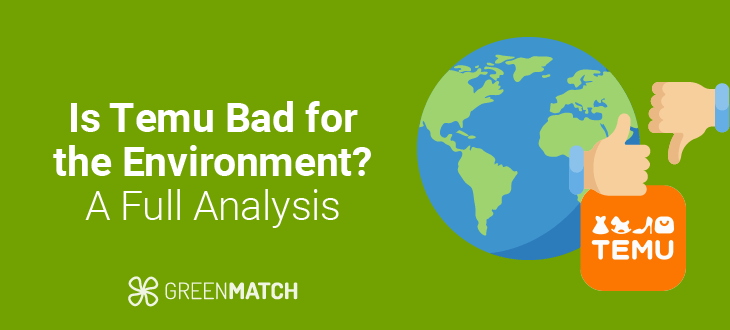
- Temu relies on air-freight to ship globally, which pollutes 20 to 30 times more than sea-freight.
- A 1 kg package shipped from China to the UK produces approximately 4.75 kg of CO₂, more than the equivalent of driving 22 miles in a petrol car..
- Temu’s fast fashion model contributes to the 10% of carbon emissions produced by the fashion industry, adding to the 92 million tonnes of clothes discarded yearly.
- Using online retailers like Temu generates 4.8 times more packaging waste than offline retailers.
Since its launch in 2022, Temu has become one of the biggest e-commerce websites in almost 80 countries. Its popularity comes from its astonishingly affordable goods and free shipping, which entice many consumers to purchase through its platform.
However, there is a growing concern about Temu’s environmental impact. From high-carbon emissions due to air-freight shipping, packaging waste, non-recyclable materials, excessive usage of plastic and ambiguous ethical codes, Temu’s operations raise serious sustainability and ethical concerns.
In this article, we will take a deep-dive into Temu’s environmental footprint, highlighting its low cost, its pros and the environmental concerns of its cheap products. We will also assess whether the platform is truly as harmful as critics suggest. Can Temu adapt and become more eco-friendly, or is its low-cost model fundamentally unsustainable? Let’s break it down.
What is Temu, and how does it operate?
Temu is an online marketplace originating from China that connects multiple manufacturers directly with shoppers, offering a vast selection of heavily discounted products, including electronics, clothing, home goods, and toys. With worldwide delivery, Temu makes it easy to find an affordable version of almost anything you're looking for.
Founded in September 2022 by PDD Holdings Inc, Temu is a sister company of the popular Chinese e-commerce site “Pinduoduo”. In April 2023, Temu UK launched, followed by the rest of Europe.
Although similar to other online marketplaces such as Amazon, Wish, Shein, and AliExpress, Temu stands out with its heavily discounted prices, consistent clearance offers, referral programs and gamification of the shopping experience with the promise of winning free gifts, promotional codes, and bonuses.
As a result of its many offers and hugely discounted prices, Temu has become one of the UK’s most downloaded apps. According to the Times, it is the UK’s most popular e-commerce app and has more than 100 million users. As of January 2025, the Temu app has been downloaded 49 million times.
Why is Temu so cheap?
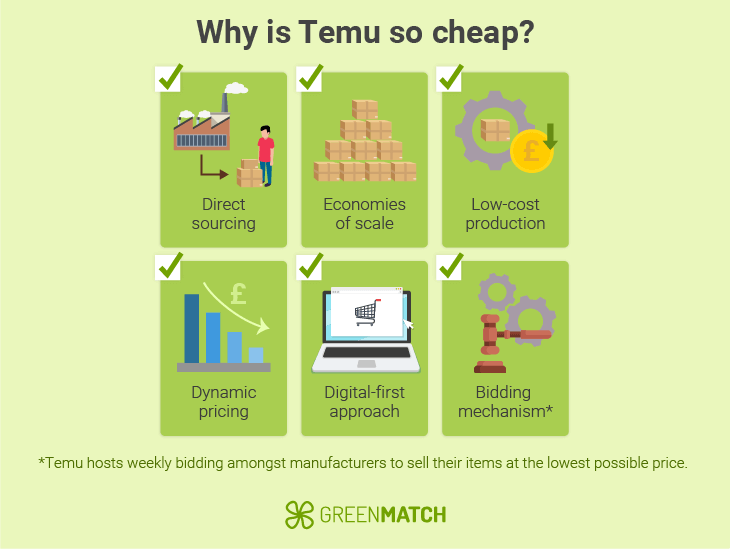
A question that often comes up when looking into Temu is: How is it so cheap? Temu’s ability to offer low prices comes from its multi-layered business model, which eliminates traditional retail markups.
Here is how they do it:
- Direct sourcing: Temu connects manufacturers to shoppers, cutting out the middlemen like distributors and retailers, who typically markup prices to increase their profit. By removing the middlemen, Temu can continue to sell its products at a low cost.
- Economies of scale: Temu can purchase massive quantities of products at discounted rates, resulting in lower prices for the consumer.
- Low-cost production: Most Temu products are manufactured in China, where large-scale production, lower labour costs, and an extensive supply chain contribute to reduced production expenses.
- Dynamic pricing: Temu uses dynamic pricing, which updates the costs of products based on their popularity which ensures optimal pricing to maximise profits.
- Digital-first approach: By operating purely online, Temu cuts expenses such as rent, utilities, in-store staff, and maintenance, allowing them to offer products at lower prices.
- Bidding mechanism: Temu hosts weekly bidding amongst manufacturers to sell their items at the lowest possible price. Sellers who can offer the lowest prices have their products stocked.
As a result of their clever muti-layered business model, Temu made an estimated $70.8 billion in 2024, an impressive 293.33% increase from its estimated $18 billion revenue in 2023.
Environmental impact of Temu
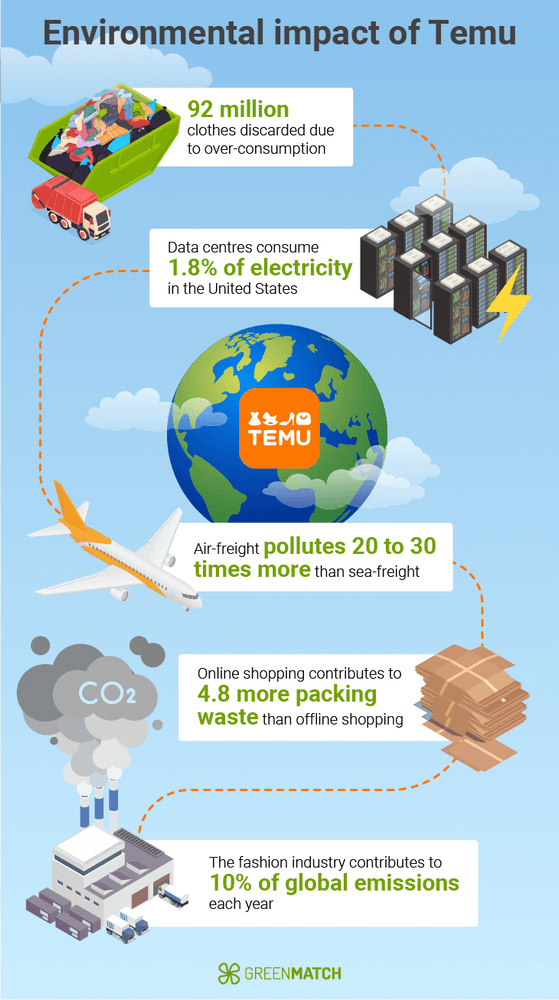
While we do not have exact data on Temu's environmental impact, we can deduce whether or not It has a damaging effect on the environment using current data.
- Over-consumption: Each year, 92 million tonnes of clothing are discarded. With sites like Temu encouraging consumers to ‘shop like a billionaire’ through heavily discounted prices, the cycle of over-consumption only worsens.
- Data centres: Temu, much like other e-commerce sites use data centres to help manage inventory, process orders and provide customer service. However, according to a 2021 study, data centres consume 1.8% of electricity in the United States.
- Air-freight deliveries: While many China-UK deliveries travel by sea, Temu has taken to air-freight to ship their deliveries. Air-freight pollutes 20 to 30 times more than sea-freight. Showing that Temu is currently not taking the necessary steps to become more sustainable.
- Fast fashion: Temu contributes to the fast fashion industry, which depletes resources like water and energy. On average, the fashion industry contributes to 10% of global emissions each year.
- Packaging waste: Temu, as with many e-commerce sites have less than eco-friendly packaging. Many products use single-use plastic, applying multiple layers per item. A 2022 study deduced that online shopping contributes to 4.8 times more packaging waste than offline shopping, potentially resulting in a 10% increase in total waste within the next decade.
Temu's environmental impact remains unclear as it does not provide transparency on its sustainability practices. Although partnering with “Trees for the Future” , contributing to over 17,549,702 trees being planted, Temu’s annual sustainability reports remain minimal and vague. This compared to other large-scale companies offering detailed annual reports on their sustainability practices should raise some environmental alarm bells.
With the absence of this information, the general public is left in the dark about what impact shopping on Temu does to our planet” - GreenPeace
By failing to disclose key environmental data, Temu prevents the consumer from making informed decisions. Without this transparency, there is no way we can determine whether Temu is making meaningful steps towards sustainability. This lack of accountability, allows Temu to sidestep environmental responsibility, potentially contributing to excessive carbon emissions, resource depletion, and pollution.
Environmental Impact Compared to Everyday Things
Temu's environmental impact remains disclosed, making it difficult to compare the affect it has on the planet. However, using data we already have we can compare how much CO2 is produced by Temu against everyday things.
Let's look at shipping. Temu uses air-freight to transport their goods worldwide. Air freight emits approximately 500 grams (0.5 kg) of CO2 per tonne-kilometer. Using this data, we can estimate the environmental cost of shipping a 1 kg package from Temu.
- The average distance between China and the UK is around 9,500km.
- Multiplying this by 0.5kg CO2 per tonne-kilometre will provide us with 4,750 kg CO2 per tonne-kilometre.
- Per Kilogram: 4,750 kg CO2 / 1,000 kg = 4.75 kg CO2.
Therefore, for every 1kg of packages sent by Temu would result in approximately 4.75kg of CO2 emissions. This may not seem like anything to you yet, but let’s compare it to everyday things.
| Activity | Co2 emissions (kg) |
|---|---|
| 1kg of Temu shipped items to the UK | 4.75 kg CO2 |
| Driving a petrol car (per mile) | 211.2 grams CO2 |
| Watching ten hours of Netflix | 0.36 kg CO2 |
| Single-use plastic bag | 1.58kg CO2 |
This data shows that shipping a package weighing a bag of sugar will emit more CO2 than watching ten hours of Netflix. Additionally, you can drive up to 22 miles in a petrol car and still produce less emissions than shipping 1kg of Temu packages.
Top Temu purchasing countries
Since its launch in the U.S. in 2022, it has rapidly grown in popularity worldwide. Although Temu does not share its net worth, its gross merchandise volume is available. In 2024, the GMV of Temu was $70.8 billion.
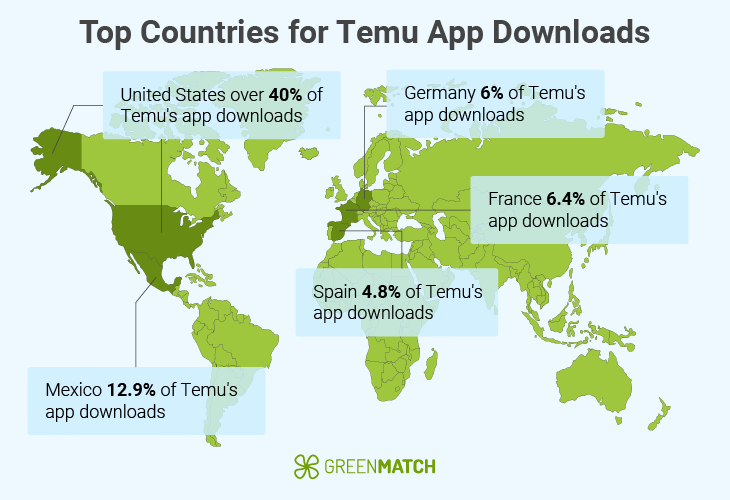
- The United States: As of September 2023, the United States is Temu's largest market, boasting 82.4 million active users on the app. Over 40% of the app's downloads originate from the U.S., mainly due to its aggressive marketing strategies, which include Super Bowl advertisements and gamifying the shopping experience.
- Mexico: Mexico is Temu's second-largest market, accounting for 12.9% of its downloads, following the United States.
- United Kingdom: The United Kingdom is Temu’s largest market in Europe, with 7.4% of its app downloads coming from the UK. British consumers have embraced Temu's competitive pricing.
- France: With 6.4% of total downloads, Temu is quickly becoming one of France's most popular e-commerce sites. Currently, it ranks fourth among the most popular websites and continues to rise in popularity.
- Germany: Germany is closely followed by France, with 6% of Temu's app downloads coming from this country. It is currently the fourth most popular e-commerce platform in France.
- Spain: In 2024, Temu has become the most popular app in Spain, surpassing sites like AliExpress and Amazon with over 15 million downloads. As a result, Spain accounts for 4.8% of total app downloads worldwide.
Temu has solely focused on expanding in Europe and the Americas. However, its rapid growth has allowed the company to expand into multiple countries across the globe including, the Asian and Middle Eastern markets. This expansion is driven by Temu’s use of Next-Gen Manufacturing, a business model that optimises everything from product development to delivery. Additionally, with PDD Holdings' extensive network of merchants, Temu can keep costs low for customers. However, its expansion has not been without challenges and pushback.
Recently, Temu has suffered a significant setback when Indonesia, the largest e-commerce market in Southeast Asia, decided to ban its website in order to protect smaller merchants. Following this, Vietnam suspended the app, citing Temu’s failure to comply with its E-commerce and Digital Economy Agency’s registration requirements, according to Reuters.
Temu has become the lightning rod for every regulator, everywhere now getting worried about whether cross-border import rules should be changed” - Simon Torring
Beyond regulatory concerns, Temu also faces scrutiny over sustainability and its environmental impact. Additionally, many countries worry about the strain on their local economies. Reuters reported that nearly 2,000 factories in Thailand shut down in 2023, partially due to increasing competition from Chinese e-commerce platforms. Small merchants worldwide are struggling to compete with giants like Temu, whose aggressive pricing strategies continue to reshape global markets.
Statistics, facts, and figures about Temu
Temu is on trend to becoming one of the biggest e-commerce giants of the world. Understanding the statistics, facts, and figures that are available on Temu is essential as it allows you to understand the company’s impact on the global marketplace. This knowledge will help you decide whether you want to purchase from Temu based on its sustainability and ethical practices.
- Colin Huang, founder of PDD Holdings and owner of Temu, has an estimated net worth of $40.3 billion, highlighting the huge success of Temu and its sister platform, Pinduoduo.
- In the UK, Temu has over more than 100 million active members, making it one of the most popular online retail stores.
- The American market is the largest for Temu, with over 82 million active users.
- As of January 2025, the Temu app has reportedly been downloaded 49 million times, quickly surpassing its competitor, Amazon.
- The rapid growth and popularity of Temu have seen its gross merchandise volume increase by 293.33% as of 2024 to $70.8 billion.
- Temu has committed itself to planting a tree per purchase to offset carbon emissions with “Tree for the Future” confirming that they have contributed to over 17,549,702 trees being planted.
- It is estimated that Temu ships around 1.6 million packages a day.
- Standard free shipping takes an estimated 5 to 10 days, and express shipping, costing £9, takes 3 to 8 days.
- Online shopping agents like Temu generate 4.8 times more packaging waste than offline retail stores.
- The rapid success of Temu has had a negative impact on smaller merchants. Chain stores in the U.S are feeling the pull of this success, and an estimated 15,000 will close in 2025.
- Analysis of Temu’s products by Seoul authorities found lead in sandals sold on the site at levels more than 11 times over the permissible limit.
- Fast fashion companies like Temu can contribute to 10% of global emissions each year.
Is Temu ethical?
It has been long debated whether Temu is ethical or not. Concerns have been raised about Temu’s supply chain transparency, labour conditions, sustainability practices, and data privacy policies. With its affordable prices and access to millions of merchants, can this company be too good to be true?
While Temu denies any unethical practices and promises it complies with current ethical standards, it has not stopped activists and lawmakers’ concerns of this massive e-commerce platform. Temu’s ethical policies and practices remain largely unknown to the public, which should raise some red flags.
In the U.S., lawmakers are investigating the potentially “high risk” use of forced labour in massive platforms such as Temu, Shein, Nike and Adidas that goes against the Uyghur Forced Labor Prevention Act, according to the BBC. Currently, Temu does not have any system in place to comply with this act.
The Uyghur Forced Labor Prevention Act ensures goods made with forced labour in the Xinjiang Uyghur Autonomous Region of the People’s Republic of China do not enter the U.S.
This investigation has stirred more discussion on whether or not using Temu is ethical. As a result, the UK parliament has begun raising concerns about whether or not Temu aligns with their Modern Day Slavery Act 2015. Chloe Cartson from Anti-Slavery here in the UK has called on Temu to have “full transparency on its supply chain”. Unfortunately, Temu has yet to respond.
“It is imperative consumers, but also governments, know the circumstances and the situations in which goods are manufactured and brought to market” - Chief Executive of Unseen, Andrew Wallis OBE
Temu's ethical controversies
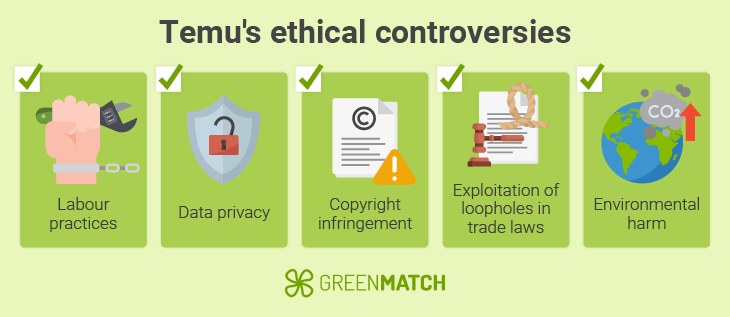
- Labour practices: Concerns have been raised about some of Temu’s products being linked to regions associated with forced labour. The company itself admits that it does 'not expressly prohibit third-party sellers from selling products based on their origin in the Xinjiang Autonomous Region,' as outlined by The Select Committee, which raises questions about its commitment to preventing forced labour. Additionally, cheaper clothes and products are often produced at the expense of workers, resulting in unethically low wages.
- Data privacy: Last year, a group of Canadian consumers filed a class action lawsuit against Temu, citing the company “collecting more data from its users than is necessary and in a greater amount than what it discloses,” according to Top Class Actions. Although Temu denies that it uses hidden malware or malicious software, this discussion and lack of transparency undermine trust and raise privacy concerns for its users.
- Copyright infringement and intellectual property theft: Many independent artists have highlighted their growing concerns at finding their designs stolen by Temu manufacturers. Elizabeth Harbour, an illustrator, told the BBC of her experience of finding one of her and while Temu promptly removed this stolen design, it raises concerns about their policies of preventing intellectual property theft.
- Exploitation of loopholes in trade laws: Temu benefits from "de minimis" import laws in the U.S., allowing packages under $800 to enter duty-free, bypassing trade regulations that traditional retailers must follow. As a result, this puts businesses at a disadvantage, adds to unfair competition, and potentially affects the global economy.
- Environmental harm: Little is known about Temu’s sustainability practices as their reports remain largely vague. However, Temu promotes over-consumption, leading to an increase in waste every year. Additionally, as they ship over 1.6 million packages a day, Temu also contributes to carbon emissions set off by air and sea freights.
Is Temu sustainable?

Temu’s business model and fast fashion output promote over-consumption, making it inherently unsustainable. While it attempts to offset its carbon footprint by planting trees, daily shipping, reliance on cheap labour, and use of low-quality materials may contribute to landfill waste. This reinforces Temu’s status as being an unsustainable company.
According to Greenpeace investigations, Temu does not disclose any of its sustainable or climate practices. The closest thing to a sustainability report was from their sister company, Pinduoduo, from 2020. With the lack of information, we cannot verify whether Temu is making meaningful efforts to combat climate change.
The lack of transparency is concerning for several reasons:
- Environmental accountability: Temu is a fast-fashion company that relies on mass production, global shipping and synthetic fibres, which can contribute to carbon emissions. Without transparency, we have no idea of the true environmental cost of its production.
- Greenwashing risk: Temu has confirmed that they plant a tree per purchase. While this is a positive fact, it can be considered greenwashing as they do not disclose clear data, which means they can market themselves as sustainable while actually engaging in unsustainable and unethical practices.
A company hiding information should raise serious concerns about hidden environmental damage, worker exploitation, and potential regulatory violations. If Temu is not reporting emissions, waste disposal practices, or water consumption, it suggests that its environmental impact could be far worse than assumed, making it a major red flag in the fashion industry. Until Temu becomes more transparent in its policies, we must assume that it is not a sustainable company.
Can Temu products be recycled?
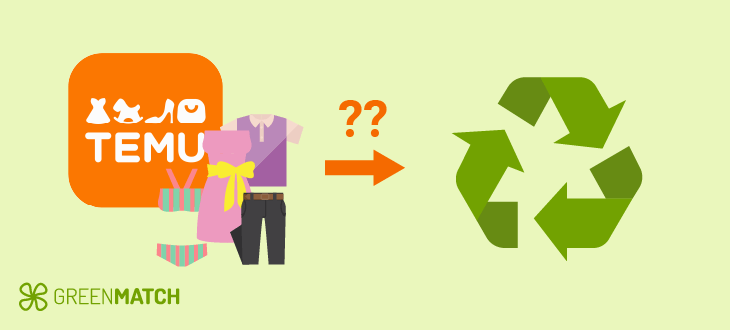
Temu offers a wide range of products, many of which are made from plastics and synthetic fibres. Although there may be a few products available that are recyclable, it is important to look into the product description to see what the item is made of. Then, you can determine whether or not it is an eco-friendly and recyclable product.
We researched the best sellers on the Temu UK site to see if any of their products were made from recyclable materials. We discovered that most of their fabric products, such as throws, couch covers, mattress toppers and clothing, were made from polyester.
Polyester can be recyclable, especially if it is rPET, but there are limited recycling facilities available to help break down this material. As a result, this material often ends up in landfills.
Temu’s polyester-based products do not contain the rPET symbol, meaning they are likely unrecyclable. Globally, only about 1% of textiles are recycled, while the rest are either incinerated or added to landfills. Additionally, the production of polyester is damaging to the environment. It is non-biodegradable and emits microplastics. A study in 2022 found that 70 million barrels of oil are used to produce polyester a year.
What are alternatives to Temu?
If you are looking for alternatives to Temu that offer affordable prices, then there are a few platforms you can consider:
- Amazon: One of the largest e-commerce platforms available, offering an array of products and services, including second-hand and refurbished goods through its Amazon Renewed program. However, concerns remain regarding its environmental footprint and labour practices.
- AliExpress: Online marketplace providing affordable prices for a wide selection of products such as electronics and clothing. Similar to Temu, AliExpress is a fast fashion e-commerce platform which contributes to over-consumption. Additionally, it does not provide any transparency on its factory and labour practices.
- Shein: A global fast-fashion retailer focused on trend-driven, affordable clothing and accessories. Its fast-fashion model is considered unsustainable and has been accused of using harmful chemicals in their products.
- DHgate: A wholesale marketplace offering bulk purchasing options, suitable for buyers looking for deals on larger quantities. However, many question the sites legitimacy and whether it is eco-friendly given its vague policies, poor customer service and poor quality products.
- Etsy: This is an online platform that allows independent sellers to sell their goods, from vintage items to unique handmade goods. Etsy is considered a very sustainable business, offering reduced packaging and encouraging their sellers to align themselves with their practices.
- Ebay: This is an online marketplace that allows you to buy or sell used items through auctions and fixed-price listings. By promoting a circular economy, ebay marks itself as a sustainable platform.
Is Temu better than its alternatives?
No, Temu is not better than its alternatives when it comes to sustainability and eco-friendliness. While it offers affordable prices, free shipping and a vast selection of products, it lacks in transparency in its ethical and environmental policies.
Here are the reasons why Temu is not better than its alternatives:
- Product quality: Although items on Temu are low-cost, the quality of these products may be hit or miss, which can lead to items quickly becoming inefficient or broken.
- Environmental impact: The use of plastic, synthetic materials, and air freight deliveries makes the company unsustainable.
- Shipping times: Free shipping takes 5 to 10 days, which is much longer than other platforms, as their products are shipped from China.
- Transparency issues: Temu has vague reports on its supply chain, data privacy and ethical practices, which can be alarming to many looking to support a business that is determined to follow ethical and sustainable standards.
As a result of these shortcomings, some alternatives to Temu are considerably better. Here is a comparison table of some alternatives compared to Temu:
| Platform | Shipping times | Average price | Product variety | Environmental impact |
|---|---|---|---|---|
| Temu | 5-10 days | £1-£10 | High | High |
| Shein | 6-8 days | £5-£15 | Moderate | High |
| Amazon | 3-5 days | £5-£100 | Very High | Moderate |
| Etsy | 3-7 days | £20-£100 | Very High | Low |
| Ebay | 3-7 days | £20-£100 | High | Low |
Future outlook
Temu’s rapid growth in just over three years shows its potential to become one of the biggest e-commerce platforms in the world. However, its lack of transparency on its ethical and sustainable practices raises concerns. While its popularity stems from its low-cost products and free shipping, its long-term impact on the environment remains in question.
Although it does not seem like Temu will make changes in proving that they are helping to reduce their impact on the environment anytime soon, there is still hope. By educating ourselves on the risks of fast fashion and over-consumption of material goods, we can help reduce our carbon footprint and pressure governments to tighten their policies on sustainable and ethical standards.
By tightening restrictions and enhancing policies to ensure high standards of ethics and sustainability, Temu may be influenced to follow in its competitors' footsteps in investing in greener initiatives and reducing its environmental harm in the future.
FAQ
Temu’s business model which promotes over-consumption, heavy reliance on air-freight and use of non-recyclable products raises serious concerns about its environmental impact.
Temu works alongside Tree for the Future to plant a tree per purchase, helping the company offset their carbon emissions.
No Temu’s fast fashion model is not sustainable as it relies on fast production cycles contributing to waste. As a result, Temu’s fast fashion model contributes to the 92 million tonnes of clothes discarded per year.
No, Temu is not considered an ethical brand due to a lack of transparency in its supply chain, potential links to forced labour, data privacy concerns, environmental impact from fast fashion practices, and excessive carbon emissions from global shipping.

Caoimhe is an experienced content writer and researcher who is passionate about providing accessible information to every reader. With a background in English literature and Sociology, she combines the two disciplines to create cohesive, well-thought-out, and well-informed pieces.
We strive to connect our customers with the right product and supplier. Would you like to be part of GreenMatch?

- Is Temu Bad for the Environment? A Full Analysis
- What is Temu, and how does it operate?
- Environmental impact of Temu
- Top Temu purchasing countries
- Statistics, facts, and figures about Temu
- Is Temu ethical?
- Temu's ethical controversies
- Is Temu sustainable?
- Can Temu products be recycled
- What are alternatives to Temu?
- Future outlook
- FAQ
